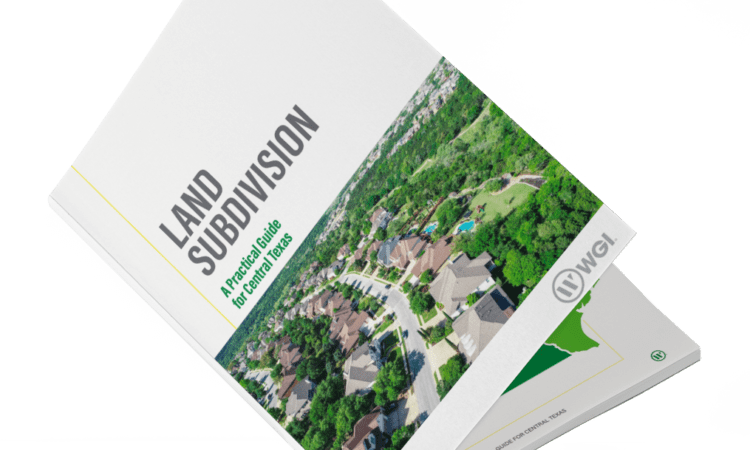
Platform Group to unveil mixed-use development in Boulevard Oaks
The Platform Group, a Houston-based real estate and investment group, will open its first project, a mixed-use retail and office development, this May.
Learn from award-winning professionals — explore our whitepapers, blogs, and the latest industry updates.
Join our dynamic organization of engineers, land surveyors, landscape architects, environmental scientists, and architects!
Talk to a market leader today! We’ll answer any questions you have about our professional services.


Land Subdivision: A Practical Guide For Central Texas
In the State of Texas, all development by private entities must occur on a legal lot or platted parcel. Therefore, all Texas land (real property) is subject to subdivision regulations, whether imposed by a county, a municipality, or both.
The land-development process is broken down into three general components:
The process’s second stage, the legal subdivision of land, typically culminates in the creation of an officially recorded subdivision plat.
In the State of Texas, all development by private entities must occur on a legal lot or platted parcel.
Commonly, the term “plat” is applied to both tax plats and title surveys; this is a misuse of the technical term. A tax plat and title survey can be used to help determine the property’s location and any encumbrances or agreements associated with it, but these documents don’t create subdivision status.
Also, a “subdivision plat” is not a permit. Nothing is built with a recorded subdivision plat alone; it is not a construction permit any more than an ownership deed. It is just a legal document recorded at the County Clerk’s office.
A subdivision plat is not a permit to construct anything – it is simply a legal document.

Generally, the need to subdivide a parcel is required any time a tract, “is divided for the purpose of selling or otherwise conveying ownership interest or as the initial stage in the development process.” (State of Texas Local Government Code Section 212.004 and 232.001)
Both currently and historically, a portion of a larger land tract is often conveyed by a land surveyor’s metes-and-bounds description of the property. It initially bypasses the requirement to legally subdivide, though the property is, in effect, subdivided. However, before the property owners develop their newly acquired land, they are likely required to file a subdivision plat application with the appropriate jurisdictional authority unless exempted under state or local exception clauses.
In counties, cities, and ETJs, the land-subdivision process broadly governs and sets restrictions on how property may be developed, including the layout of streets, utilities, drainage infrastructure, and other public improvements. With limited exception, the land-subdivision process doesn’t govern specific use or density of the subdivided land.
In fact, there are only four statutory requirements a plat must meet to receive approval and recordation:
Even so, a county or city may attach additional subdivision ordinances to these minimum Code requirements. If there are no additional local ordinances in effect, and all four requirements are met, then the subdivision must be approved and recorded under State law (Local Government Code Sections 212.005, 212.010, and 232.002(a)).
The subdivision process typically has two main steps: 1) the Preliminary Plan, and 2) the Final Subdivision Plat(s). While rare in counties, many municipalities also require a general concept plan in the initial submittal. For example, the City of Round Rock requires the submittal of a concept plan prior to accepting any preliminary plan for review, and the City of Austin requires a master development plan for tracts consisting of more than one preliminary plan section.
The preliminary plan typically includes all land under contiguous and common ownership. In the City of Austin, a preliminary plan is required when more than four lots are created, or public right-of-way for a new street is being dedicated. The preliminary plan is a graphic representation of how a particular land parcel will be incrementally subdivided and subsequently developed.
A preliminary plan is as its name suggests — a preliminary planning document — and is not subject to recordation in the official county records. Approval of a preliminary plan typically represents the baseline for obtaining vested development rights under Chapter 245 of the Local Government Code. Preliminary plan approval also establishes a commitment from the affected utility provider to supply utility services in accordance with the approved plan.
The final subdivision plat is a legal document recorded at the County Clerk office where the land is located. Once recorded, a final subdivision plat never expires (for an exception to this statement, reference Section 232.002 (c) of the Local Government Code).
A final plat application, in compliance with the approved preliminary plan and the requirements published by the applicable jurisdictional authority, must be approved under State law (Local Government Code Sections 212.005, 212.010, and 232.002(a)). The final plat must be significantly like the approved preliminary plan.
There is no limit to the number of final plats created from a single preliminary plan (COA Code 25-4-81). Additionally, when any one section of a preliminary plan is final platted, the underlying final-platted preliminary plan section is considered null and void — but not the balance of the preliminary plan.
In the City of Austin, a plat creating four or fewer lots may be approved administratively, provided all new lots have frontage on an existing street, and utility availability. If the plat application does not meet these requirements, it will necessitate approval by the applicable land-use commission.
Barring a plat vacation, the resulting legal lots can be re-subdivided or amended as described below without the need to revise the original preliminary plan — assuming the re-subdivision itself does not trigger a preliminary plan. Once a portion of a preliminary plan is final platted, the underlying section of the preliminary plan is considered null and void; only those unplatted sections of the preliminary plan remain on the applicable preliminary plan.
Subdivision plats may be vacated, partially or in full. There are also two additional standard plat-types considered to be final subdivision plats — re-subdivision plats (replats) and amending plats.
A final plat may be vacated, or canceled, through the final plat-vacation process (Local Government Code Sections 212.013 and 232.039). The only way to remove easements dedicated by plat, notes, covenants, or restrictions from a subdivision plat is to vacate the plat in its entirety or to partially vacate the plat in full-lot increments.
Single legal lots that aren’t right-of-way cannot be partially vacated (one lot cannot be partially vacated and remain a legal lot). However, unimproved right-of-way dedicated by plat can be partially vacated from other contiguous rights-of-way dedicated within the same plat via a surveyor’s metes-and-bounds description.
All current landowners within the subdivision must approve and sign the plat-vacation documents, even if their lot is not vacated. With few exceptions, a public hearing is required for a plat vacation.
A re-subdivision plat (replat) creates a new land subdivision, increasing the number of legal lots from a previously platted parcel (Local Government Code Sections 212.014 and 232.040). One important aspect of a replat is that all restrictions applicable to the original subdivision will also apply to the re-subdivision.
Additionally, all replats require a public hearing prior to approval. Covenants, easements, notes, setbacks, and restrictions shown on a subdivision plat cannot be removed through the re-subdivision process. Instead, they must be addressed through a plat vacation and new final plat.
An amending plat, sometimes referred to as a plat revision, allows a property owner to move lot lines between two or more contiguous lots, address minor documentation errors, make known any changes in property monuments, or similar purposes (Local Government Code Sections 212.016 and 232.041). With limited exceptions, amending plats doesn’t require a public hearing prior to approval. Like the re-subdivision process, all applicable restrictions on the original subdivision also apply to the amending plat.
Like every rule, the requirement to subdivide has exceptions. Potentially, they include those mandated by state law and additional local exceptions.
The most prominent city exception found in the Code is the five-acre municipal exemption. It allows the land subdivision into tracts of five acres or more, if each tract has access to a public street and no public improvements are necessary (Local Government Code 212.004).
Another exemption applies to property adjacent to small airports. The airpark exemption applies to cities with less than 5,000 people, allowing land subdivision into tracts of 2.5 acres or more with frontage on an aircraft runway (Local Government Code 212.0046).
Chapter 232 of the Local Government Code outlines several county exceptions to the land-subdivision requirements. Most common is the 10-acre exemption, allowing a landowner to subdivide into tracts of 10 acres or more as long as public right-of-way is not dedicated. Interestingly, this exception does not require that all the lots have frontage on a public street (Local Government Code 232.015(f)).
Other county exceptions in the Code include those for land subdivision used for agricultural cultivation, family transfers creating less than four parcels, and a seller keeping a portion of his/her parent tract when the balance is sold and subdivided by a purchaser (Local Government Code 232.015).

Condominium buildings and condominium regimes are quite popular in central Texas. In addition to vertical condominium buildings, another increasingly common application is “single-family condominium” developments. Once a parent tract is legally subdivided or exempted from the requirement to subdivide, the condominium process offers a legal way to further divide property among ownership interests.
The Texas Property Code explicitly states that, “the creation of a condominium regime is not a subdivision and plat approval is not required,” (Texas Property Code 82.005) and that, “a condominium plat is not a subdivision plat” (Texas Property Code 82.003). The Property Code further proclaims that, “land-use laws may not prohibit the condominium form of ownership or impose any requirement on a condominium which is not imposed on other physically identical developments under a different ownership structure,” (Texas Property Code 82.006) such as a fee-simple structure. However, to develop the property at all, the original underlying tract must be a legal lot for development purposes.

When located entirely in the jurisdiction of a county, Section 232.007 of the Local Government Code contains an exception for mobile home (trailer) parks. Under this provision, separating a tract of land into allocated spaces or “lots” for the installation of residential mobile homes — for lease only — does not trigger the requirement to subdivide.
Chapter 232 of the Local Government Code outlines several county exceptions to the land-subdivision requirements. Most common is the 10-acre exemption, allowing a landowner to subdivide into tracts of 10 acres or more as long as public right-of-way is not dedicated. Interestingly, this exception does not require that all the lots have frontage on a public street (Local Government Code 232.015(f)).
Other county exceptions in the Code include those for land subdivision used for agricultural cultivation, family transfers creating less than four parcels, and a seller keeping a portion of his/her parent tract when the balance is sold and subdivided by a purchaser (Local Government Code 232.015).
When real property is in a municipality’s ETJ, Chapter 242 of the Local Government Code mandates the municipality and affected county enter into a written agreement identifying the jurisdictional review-and-approval process for subdivision applications (Local Government Code 242.001). The authority could rest solely with the city or the county, be divided geographically between the city and county (with each keeping authority in only one portion), or a single combined office implemented to create a joint subdivision-review process. Every combination of city and county in Central Texas entered an appropriate interlocal agreement for the subdivision process with the municipality’s ETJ.
“Grandfathering rights,” as outlined in Chapter 245 of the Local Government Code, are regulatory guidelines for obtaining vested development rights on a specific project. The existence of vested rights is often referred to as “1704 Entitlements.” In fact, Texas House Bill (HB) 1704 is codified as Chapter 245 of the Local Government Code.
Vested rights – grandfathering — allow project development in compliance with only those rules and regulations in effect at the time of the initial project application. For large phased projects, these rights and what is considered the initial application date, have particularly important implications.
In most cases, the preliminary subdivision plan or final subdivision plat is the basis for Chapter 245 vested-rights claims. Any project located within a subdivision approved before September 1, 1997 (specific to the City of Austin) is entitled to some level of grandfathered rights. These rights may allow an increased level of impervious cover, exemptions from recent tree-preservation ordinances, and required water-quality treatment levels, among many land-use related items.
Of note — Chapter 245 grandfathering rights do not apply to health and safety issues, such as building or fire codes, nor to construction means, methods, or materials. The effect is that both private improvements and public infrastructure must be built to current standards, regardless of the grandfathered land-use entitlements existing on private property (Local Government Code Section 245.004).
In the State of Texas, all real property is subject to subdivision regulations, whether imposed by a county, a municipality, or both. Land subdivision is increasingly complicated, evolving from what was once a simple land division into multiple parts, creating blocks and lots, and laying out streets and parkland.
Today’s practice invites a (potentially) complex review process, including multiple applications, input from various jurisdictional review authorities, detailed engineering studies, and public notification and its requisite public hearings prior to approval.
It is critical that the modern land-development professional — be it attorney, engineer, developer, surveyor, or other real-estate consultant — is knowledgeable about the land-subdivision process, protecting the best interests of those involved.
For more information about this study or to have a conversation with one of our experts, please contact us:

Land Subdivision: A Practical Guide For Central Texas

WGI is a national design and professional services firm leading in technology-based solutions for the construction of public infrastructure and real estate development. At WGI, we’re providing Tomorrow’s Infrastructure Solutions Today.

The Platform Group, a Houston-based real estate and investment group, will open its first project, a mixed-use retail and office development, this May.

WGI’s visualization team investigates cutting-edge tools to visualize, understand, design, and manage the built environment.

A rapid assessment tool that helps uncover the emerging technologies and trends that are of strategic importance to your business.

WGI is pleased to announce it acquired Texas-based BIG RED DOG, INC. (BRD), a firm with a reputation in the industry for intelligent disruption, and a leading provider of civil, MEP, structural, traffic, and transportation engineering for public and private clients.

In this episode of WGI Unleashed, we get to know Shayna Johnson, Team Leader for our Civil Engineering group in the Houston, Texas office.

The Waterford Campus Redevelopment in Juno Beach showcases WGI’s multi-disciplinary expertise in enhancing senior living through innovative design and expanded amenities, setting a new standard for care and elegance.
You’ve been searching for a place like WGI. We look forward to meeting you soon.
Land subdivision is increasingly complicated, evolving from what was once a simple land division into multiple parts, creating blocks and lots, and laying out streets and
parkland.
Today’s practice invites a (potentially) complex review process, including multiple applications, input from various jurisdictional review authorities, detailed engineering studies, and public notification and its requisite public hearings prior to approval.
WGI © 2020 | 2035 Vista Parkway, West Palm Beach, FL 33411
Sign up to receive emails to hear our latest news and achievements in our monthly newsletter.
Enter your zip code, and we’ll personalize your experience with local projects, office locations, team members, and more.
WGI supports its associates with meaningful opportunities for growth, strong benefits and perks, while we work collaboratively with clients and co-consultants to shape and improve communities.






WGI is a dynamic organization with opportunities nationwide for engineers, land surveyors, landscape architects, environmental scientists, and architects.